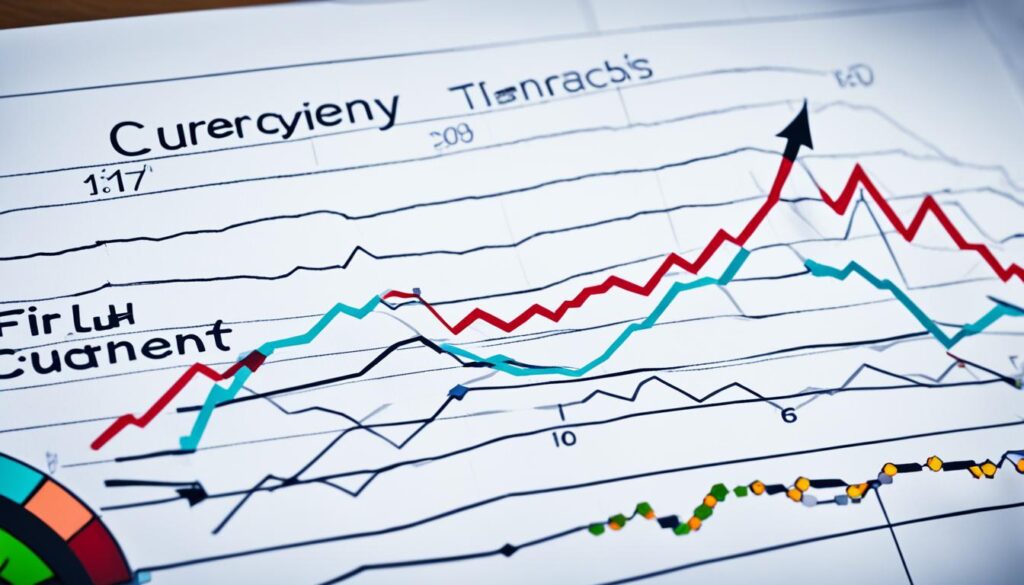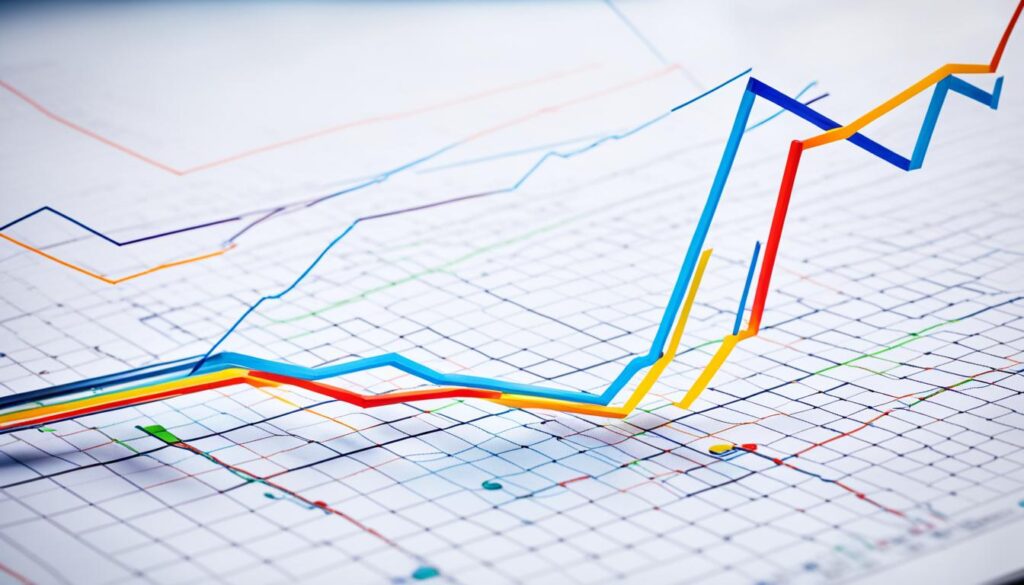What is a Trend in Forex Trading?
Did you know that 74% of retail CFD accounts lose money in Forex trading? Trends are key here, affecting whether traders succeed or fail. Knowing about trends is vital for anyone looking to invest in the Forex Market or master Forex Trend Stages.
A trend in Forex trading shows the way currency prices move over time. It’s something every trader uses to their advantage. They use different tools, like moving averages and RSI, to spot these trends. These trends can be short-term, long-term, moving up, down, or staying flat. Knowing these trends lets traders pick the best times to buy or sell. This choice can really boost their earnings.
Key Takeaways
- Knowing about Forex trading trends can cut losses and boost profits.
- Trends come in different types, like short-term and moving up.
- Indicators such as moving averages and RSI are vital for spotting trends.
- Factors like interest rates and big world events change Forex trends.
- Top traders use large-scale economic info to shape their tactics.
Introduction to Trends in Forex Trading
Understanding trends is key to winning in forex trading. A trend shows the main way that prices are going. Knowing about trends is essential for anyone in Forex Trading Psychology. By spotting trends, traders can plan well and choose wisely.
Definition of a Trend
A forex trend means prices are moving the same way. This can be either up (bullish) or down (bearish). Traders look for trends by drawing lines between high and low points. This shows levels where the price may again change.
Importance of Identifying Trends
Finding trends is very important in forex. It helps to know when to buy and sell without risking too much. Also, understanding trends gives a peek into what the market is feeling. This is key in making smart trading plans.
By keeping an eye on trend lines and support and resistance, traders can move wisely. This includes using data analysis and understanding how people’s feelings affect the market. Doing so, they improve how they make trading choices.
Trading trends in forex mean looking at a whole picture, not just the movement. It’s about understanding trends, economic health, and how psychology shapes the market. With the right tools, traders can build strong strategies. These strategies help them make money.
Types of Trends in Forex Trading
In Forex trading, it’s key to know the various trend types for good decision-making. There are three main trend categories: uptrends, downtrends, and sideways trends. These trends present specific chances and difficulties because of how currency pairs move due to market changes.
Uptrend (Higher Lows)
When prices are rising, we call it an uptrend. This trend is shown by higher highs and higher lows, pointing towards strong buying. Using tools like moving averages and MACD can help traders spot the trend’s power. Spotting uptrends is easier with indicators like Bollinger Bands, which can also predict profit-taking zones at the uptrend’s peak.

Buying currencies near moving averages, like the 50 or 200-day average, is a common uptrend-trading strategy. To protect and grow their profits, traders use trailing stops. These stops move upwards with the price, keeping profits secure.
Downtrend (Lower Highs)
In contrast, a downtrend shows falling prices, displayed by lower lows and lower highs. In this trend, traders seek selling opportunities. Indicators like the RSI can tell when a market is overbought. For example, if the RSI exceeds 80 for three days, it might hint at a market turn.
For traders confirming a downtrend, the MACD is useful. It’s used alongside other strategies. When prices hit the lower Bollinger Band, traders often choose to take profits. They also place stop losses above the trend to reduce risk.
Sideways Trend (Ranging)
A ranging market, also called a sideway’s trend, shows price movement within a set range without a clear up or down direction. It means buying and selling pressures are balanced. This leads to low volatility. In a sideways trend, it’s important to find where prices mostly stop, which are support and resistance levels.
One method for benefiting in a ranging market is buying low and selling high. Trendlines can be placed on the pivot points to predict when a market will break out of its sideways movement. This marks a potential shift in momentum.
Knowing these trends and using the right tools can greatly improve trading. It’s crucial to understand the market’s length, medium, or short-term trends. Recognizing trends and market activity helps in making the right decisions for a successful Forex trade.
Stages of a Trend
It’s vital to know the steps of a trend for good Forex trading. Trends in Forex move through clear stages, much like Elliott Wave Theory explains. Understanding these stages can help traders guess the market’s future direction better. This can lead to smarter choices.
Impulse Waves
According to Elliott Wave Theory, impulse waves are major movements that go with the big trend. These waves have five smaller waves, showing strong momentum in the same direction. The Imbalance phase starts this off. In this phase, one group of orders is much bigger than the other. This can change the market’s direction.
- Imbalance Phase: This marks the trend’s start as one side gets many more orders than the other.
- Advancing Phase: At this point, smart traders may get in, pushing prices up further with each trade.
Corrective Waves
Corrective waves go against the main trend. They usually have three smaller waves and show a ‘pause’ for the market. The Liquidation phase is like a big break, as traders start to close their losing trades. This adds more sell trades, affecting how the market moves.
- Liquidation Phase: Traders closing bad trades add new orders, which can slow or reverse the market.
- At this point, we often see lower highs and lows, showing a break from the main trend.
End of Trend
We can often tell a trend is ending by certain price patterns and levels. The last phase includes the Awareness stage. This is when traders see the new market direction. Their reaction starts a wave of new orders, finishing the trend’s cycle. Knowing this stage is key. It lets traders adjust their strategies to protect their gains or get ready for changes.
- Distribution Phase: Here, after prices rise, the market pauses. Bulls and bears are in balance.
- Declining Phase: After the pause comes a phase with lower highs and lows. This often marks the old trend’s end.
Technical Analysis for Identifying Trends
Spotting trends is vital in the Forex market. It helps traders’ decisions with solid data. Tools for Technical Analysis play a key role in understanding market trends and momentum.
Moving Averages
Moving Averages are critical for seeing the trend’s direction by smoothing out price changes. When prices go over the Moving Average line, it might show it’s time to buy. This suggests the market is going up. Each Moving Average works best with specific time frames and calculations. For example, using Moving Averages helped predict a major 3,300 pip drop in the EURUSD exchange over 44 weeks.

Trend Lines
Trend lines help us see which way the market is moving by marking high and low price points. They make it easy to spot when a trend might change. For instance, on the AUDJPY chart, close prices around a support level foreshadowed a trend shift, proving trend lines’ value in predicting the market.
Relative Strength Index (RSI)
The RSI stands out among Technical Analysis Tools as an oscillator. It gives values from 0 to 100, showing when a market is overbought (above 70) or oversold (below 30). In stable or strong markets, RSI can confirm if a trend is reversing. Looking at the GBPUSD chart’s highs and lows, RSI indeed helped signal important trend changes, aiding traders’ decision-making.
Mixing these Technical Analysis Tools with Fundamental Analysis and other Forex Market Indicators sharpens a trader’s trend-spotting skill. When different indicators align, it can enhance traders’ confidence in their market predictions. This leads to more disciplined trading strategies.
Economic Factors Affecting Currency Trends
For forex traders, it’s vital to know how economic factors affect currencies. Interest rates, economic data, and world events play big roles in this. Each factor guides currency markets and helps smart traders make choices. Now, we’ll look into how these elements shape currency values.
Impact of Interest Rates
Interest rates greatly impact currency values. When a country’s rates go up, more people want its currency, pushing its value up. On the flip side, low rates can lower a currency’s worth. Traders keep a close eye on central banks like the Federal Reserve and the European Central Bank for hints on rate changes. This helps them avoid risks.
Role of Economic Indicators
Economic data paints a picture of a country’s financial health. Key indicators include Gross Domestic Product (GDP), inflation, and trade balance. For traders, a country with strong exports might see its currency rise. But, if a country imports more than it exports, its currency could weaken. By watching these indicators, traders can predict currency moves.
Influence of Geopolitical Events
Big global events and political problems can shake up currency markets. Things like elections and policy changes cause uncertainty. This can especially affect pairs like the EUR/USD, with the US Dollar seen as a safe option during tough times. Keeping an eye on the news for Global Economic Events helps traders manage risks and make wise moves.
| Economic Factor | Influence on Currency Value |
|---|---|
| Interest Rates | Higher rates attract investment and strengthen currency, while lower rates can weaken currency. |
| GDP Growth | Signals economic strength; higher GDP can lead to currency appreciation. |
| Inflation Rates | Rising inflation decreases purchasing power and can devalue currency. |
| Trade Balance | Positive trade balance can appreciate currency; deficits may cause devaluation. |
| Geopolitical Events | Political instability and global events can cause volatility and shift currency value. |
Examples of Currency Trends
In forex trading, knowing past currency trends is key. It helps you make good trade decisions. This part looks at currency pairs and how big economic factors and commodities affect them.
Australian Dollar Vs. U.S. Dollar
The Australian Dollar (AUD) and the U.S. Dollar (USD) are strongly linked to commodities. With lots of mineral exports like iron ore and coal, Australia’s currency (AUD) moves with commodity prices. This affects how the AUD and USD change value against each other.

Studies show AUD/USD is a very dynamic currency pair. It’s perfect for traders who want to follow market demand for commodities.
U.S. Dollar Vs. Canadian Dollar
Now, let’s look at the U.S. Dollar (USD) against the Canadian Dollar (CAD). Canada is a big exporter of oil and gas. This makes the CAD influenced by the oil market.
The relationship isn’t just about oil. It’s also about Canada and the U.S.’ economic ties. When oil prices go up, the CAD can get stronger against the USD. This shows how trends in commodities can change currency values.
Historical Trends and Patterns
Looking at past trends is key to understanding currency pairs’ long-term movements. Some, like AUD/USD and NZD/USD, are often very volatile. They’re known as commodity currencies.
Then there are pairs like EUR/GBP, which are more stable. This is partly due to the similar economic situations in Europe and the UK. Understanding these patterns can help predict future currency rates.
For traders, knowing about these past trends can help build strong strategies. It’s not just about commodities but also interest rates, world events, and more.
| Currency Pair | commodity correlation | Volatility | Investment Demand Impact |
|---|---|---|---|
| AUD/USD | High (iron ore, coal) | High | Strongly affected by commodity demand |
| USD/CAD | High (oil, natural gas) | Moderate | Closely follows oil market dynamics |
| EUR/GBP | Low | Low | Less influenced by commodities |
To trade well, you must deeply study these aspects. This understanding is crucial. It shapes today’s currency rates and tells you about future market needs.
Trend Trading Strategies
Trend trading strategies help traders take advantage of market changes. They use tools like trendlines, chart patterns, and momentum indicators. These are used to spot breakout signals and trends reversal signs. We’ll discuss three common tactics used by traders.
Trendline Breakout Strategy
In this strategy, traders focus on making money from confirmed trend advances. They draw lines connecting significant price lows in an uptrend or highs in a downtrend. When prices break these lines, opportunities to enter or exit trades appear. Traders use the Relative Strength Index (RSI) and similar tools to confirm these signals.
Ascending and Descending Triangles Strategy
This strategy looks at the momentum from triangle shapes on charts. An ascending triangle forms when the price makes higher lows against a flat top. In contrast, a descending triangle shows lower highs on a flat bottom. Breakouts usually happen at the triangle’s tip. Traders confirm these breakouts and trend strength using momentum indicators before trading.
Counter Trend Trading Strategy
Counter trend trading bets on market shifts that go against current trends. This strategy involves studying chart and price patterns for trend reversal hints. Indicators like the RSI show when a market may have turned too far, suggesting a coming change. Traders then go opposite to the current market flow.
These methods offer traders varied ways to manage market flux. By using specific technical analysis tools, and momentum indicators, it becomes easier to identify when a trend might change. This information helps traders make better decisions.
| Strategy | Description | Key Tools | Objective |
|---|---|---|---|
| Trendline Breakout | Uses trendlines to identify breakout signals. | Trendlines, RSI | Enter/Exit positions on breakouts |
| Ascending/Descending Triangles | Leverages triangle patterns to predict trend continuity. | Triangle patterns, RSI | Capitalize on market momentum |
| Counter Trend Trading | Focuses on trend reversals by predicting shifts in momentum. | Swing highs/lows, RSI | Profit from trend reversals |
Tools and Indicators for Trend Analysis
To understand the Forex Market Momentum, traders use advanced tools. These tools help make trading decisions smarter. Let’s explore some key indicators that can change how you trade.

Average Directional Index (ADX)
The Average Directional Index (ADX) measures trend strength in the forex market. It gives readings between 0 and 100. Higher values show a stronger trend, helping traders align their trades with market moves. Known for its role in Volatility Assessment, it prevents traders from following weak trends.
Bollinger Bands
Bollinger Bands help analyze market volatility. They have three lines, with a simple moving average (SMA) in the middle. The two outer lines are at the SMA’s standard deviations. These bands help traders predict market squeezes or trend continuations. They make Trend Predictions more accurate, improving market strategies.
Moving Average Convergence Divergence (MACD)
The Moving Average Convergence Divergence (MACD) tool is key for understanding trend momentum and direction. It compares short and long-term moving averages. It also looks at the MACD signal line and histogram. This analysis helps traders spot potential buy or sell signals. It’s essential for monitoring Forex Market Momentum and ensuring timely, profitable trades.
Risks and Challenges in Trend Trading
Trend trading can be both popular and profitable. But it comes with its own series of risks and challenges. The main challenge is in identifying trends correctly. The market’s liquidity changes constantly. This makes it hard to tell real trends from fake ones.
Dealing with market volatility is another key issue in trend trading. Volatile markets can change trends quickly, surprising traders. It’s crucial to use risk management tools like stop-loss orders and trailing stops. These help reduce big losses.
The mental aspect of trading is also a challenge. Traders need to keep their emotions in check. This is especially true when they overuse leverage. Staying informed about the market and sticking to good trading practices can help lessen these risks.
Now, let’s compare some key stats about trend trading:
| Aspect | Percentage |
|---|---|
| Traders using trend-following strategy | 60% |
| Use of trailing stops for risk management | 50% |
| Success rate of breakout strategy | 40% |
| Utilization of moving averages strategy | 70% |
| Average length of time holding positions | 3-6 months |
| Increase in profits with risk management | 15% |
Traders are advised to mix technical and fundamental analyses. They should also follow risk management strategies closely. This approach helps them lessen trend trading risks. It also allows them to make the most of market chances for better returns.
Conclusion
Mastering trends in Forex trading is key to being successful. By knowing and spotting trends, traders can make smarter moves.
The Forex market is huge, with a daily turnover of $7.5 trillion in 2022. It offers more chances than stocks and bonds. Using high leverage can boost profits but also raises risks. For example, in 2020, some traders nearly doubled their money during a EUR/USD jump, showing how powerful trend trading can be.
Tools like moving averages and key indicators help with market analysis. They point out when new trends might start or current ones might reverse. By spotting patterns and waiting for confirmation, you can say when a price might flip before making a trade.
But knowing the economy’s influence on currency trends is also vital. Yet, the Forex market poses risks too. Most traders often lose money. So, being watchful, sticking to a solid plan, and managing risks are crucial.
Putting together technical and economic insights with smart strategies gives traders what they need. This is true for both new and experienced traders. Understanding and acting on trends well leads to success in Forex.
